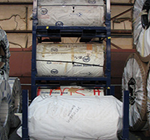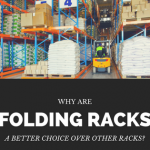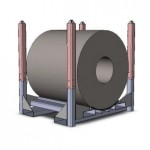Tips for Warehouse Rack Safety
Warehouse is a commercial building used for storing industrial goods. A warehouse houses different types of racks for storing products such as roll dispenser racks, coil racks, movable storage racks, etc. Warehouse is also an accident prone idea due to various reasons. Improper management of racks is one of the main reasons for warehouse accidents. To avoid rack related accidents, it is very important that warehouse owners maintain a safety checklist. The checklist should enlist series of tasks and activities to be undertaken by people using these racks. This post concentrates on a checklist of tips, which will help the warehouse managers, working staff, and lift operators to ensure their safety.

4 Tips to Keep Away Your Warehouse Rack Woes
Below are the five tips, which will help a warehouse owner or workers realize value for storage racks.
Avoid Overloading of Racks
Warehouse racks have twice load bearing capacities than other commercial racks. But it is advised not to overload these racks because they are engineered for static loads, not for lateral loads. Hence, it is important to read the specification label mentioned on the rack for understanding its load bearing capacity. Generally, manufacturers add labels on the racks, which help users to understand dimensions and specifications of the rack.
It is always assumed that weight on the rack is evenly distributed across it. The basic science behind loading the rack is ensuring heavy loads are placed on one side, with the lighter loads on the other side. This ensures an effective storage solution and helps prevent accidents that may occur due to over loading.
Ask for the Replacement Labels
Labels on various warehouse racks such as coils racks or roll dispenser racks are sturdy, and may last long. At times, the labels may be scratched off due to daily abuse. As, these labels are critical because they provide the specification of the rack to the workers. Hence, warehouse owner should take necessary steps to replace scratched labels as soon as they notice them.
Avoid Damaged Racks
Many times, warehouse owners overlook faulty bases, and other minor damages. However, these minor issues aggravate in the long run, and endanger lives of people using these racks. Hence, it is always advisable to conduct timely repairs, as soon as minor defects are noticed. Also, as per the safety guidelines, the racks that are severely damaged must be disposed at the earliest. This will help prevent accidents that may occur due to their collapsing or disintegration.
Don’t Tamper with Rack Components
Any kind of tampering in the form of drilling holes, grinding or cutting through the warehouse racks should be avoided. It is always advisable to approach the manufacturer or expert engineer for any kind of changes to be made. An expert intervention in this matter will ensure long term performance of these racks. Working with racking specialists will help you reduce injuries within the warehouse.
A safe warehouse increases the operational efficiency of any business unit. Are you concerned with your warehouse rack safety? It’s time, you must approach an industrial expert like SPS Ideal Solutions, which provides customized warehouse racks. The company provides high-quality warehouse racks, which help its customers maximize their ROI, and minimize their warehouse woes.
Warehouse Racking Specifications
Warehouse racking specifications play a crucial role in ensuring the safe and efficient operation of any warehouse facility. These specifications provide essential information about the design, capacity, and usage guidelines for each type of racking system installed in the warehouse.
Proper understanding and adherence to warehouse racking specifications are essential for maintaining a safe working environment and preventing accidents. Here are some key aspects to consider:
Load-Bearing Capacity
- Warehouse racks are engineered to support specific load capacities, which vary depending on factors such as rack design, materials used, and construction quality.
- It’s crucial to adhere to the load-bearing capacity specified by the manufacturer for each rack type to prevent overloading, which can lead to structural failures and accidents.
- The load-bearing capacity should be prominently displayed on each rack, typically on a label or placard, to provide clear guidance to warehouse staff.
Rack Dimensions and Layout
- Warehouse racking specifications include details about the dimensions and layout of each rack, including height, width, depth, and spacing between shelves.
- Adhering to these specifications ensures efficient use of available space in the warehouse while maintaining safe distances between racks to facilitate safe movement of personnel and equipment.
Material Handling Equipment Compatibility
- Warehouse racking specifications may also include information about compatibility with specific types of material handling equipment, such as forklifts, pallet jacks, and order pickers.
- It’s essential to ensure that the racking system is compatible with the equipment used in the warehouse to prevent damage to both the racks and the equipment, as well as to ensure the safety of operators.
Installation and Assembly Guidelines
- Proper installation and assembly of warehouse racks are critical for ensuring their structural integrity and stability.
- Warehouse racking specifications may provide detailed instructions and guidelines for the installation process, including recommended anchoring methods, load distribution techniques, and safety precautions.
Maintenance and Inspection Requirements
- Warehouse racking specifications may outline maintenance and inspection requirements to ensure the ongoing safety and functionality of the racking system.
- Regular inspections should be conducted to identify any signs of damage, wear, or deterioration, and prompt action should be taken to address any issues to prevent accidents.
Frequently Asked Question
What are racking load capacity labels, and why are it is useful?
Racking load capacity labels indicate the maximum weight that a rack may safely sustain. These labels are important for avoiding overloading, which can result in structural failures and worker hazards. To maintain safe storage practices, warehouse personnel should carefully read and follow these labels.
What is the meaning of racking capacity labels, and how should it understood?
Pallet racking capacity labels implies the highest weight that a pallet racking system can securely support. These labels usually provide important information like load-bearing capacities for various rack managements. To avoid accidents and injuries, warehouse staff should carefully interpret these labels and ensure that they do not exceed the prescribed weight limitations.
How can pallet racks be safely used in a warehouse?
Pallet rack safety requires several essential practices, including adhering to load capacity markings, appropriately spacing racks to allow for safe movement of persons and equipment, and performing frequent checks for indicators of damage or wear. Furthermore, staff should be properly trained on safe loading and unloading methods in order to avoid accidents and maintain a safe working environment.
What steps may be made to improve warehouse rack safety?
Warehouse rack safety can be improved by performing frequent inspections for damage, swiftly correcting any concerns, maintaining proper load distribution to minimize overloading, and avoiding illegal alterations to rack components. Warehouse facilities that prioritize safety and adherence to guidelines can reduce the likelihood of accidents and establish a safer working environment for all employees.












